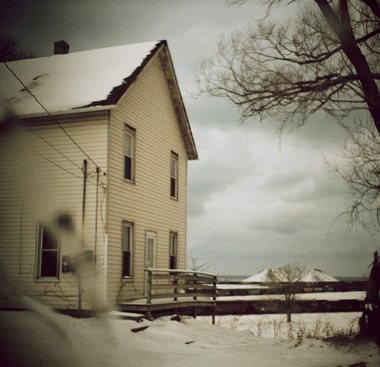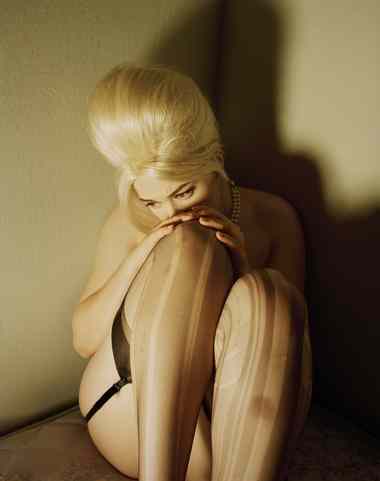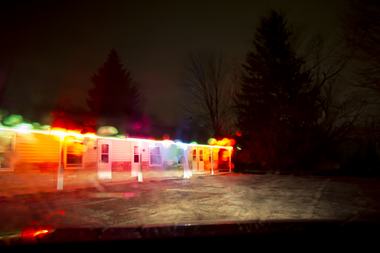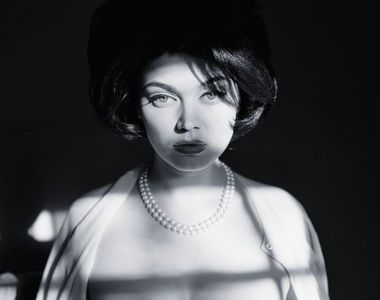Plain Dealer Reviews "Silver Meadows"
26/05/13
By Steven Litt, The Plain Dealer
May 26, 2013
Smashed cars, sexually ravenous women and lonely houses: Todd Hido photos at Transformer Station paint a pulp view of growing up in Kent
Todd Hido, a widely respected fine-art photographer based in Oakland, Calif., whose work is eagerly sought by magazine editors, leading museums and private collectors, was a happy guy last week at the newTransformer Station gallery in Ohio City.
Fueled by cigarettes and iced coffee, he worked at a laptop on a rickety card table in the middle of the nonprofit gallery as art handlers installed his latest work for a show that opened there Friday.
Simultaneously, he was doing business with a photo-printing studio in San Francisco in preparation for an upcoming show in that city, and taking inquiries from other galleries and collectors. He reveled in the fact that he was three hours ahead of his home city for a change, rather than three hours behind the East Coast.
"We're never done. There's constantly something happening," he said.
Entitled "Excerpts From Silver Meadows," the Cleveland exhibition is Hido's semifictional evocation of his childhood in Kent, Ohio, replete with images of Lake Erie in the winter, houses and leafless trees shrouded in mist, scrapbook vignettes from his own life, and images of scantily clad, sexually ravenous-looking women.
Two years in the making, the show is the outcome of a $100,000 grant from gallery owners and collectors Fred and Laura Bidwell of Peninsula, who opened the gallery earlier this year as a collaborative project with the Cleveland Museum of Art.
"They gave me much more than funding," Hido (pronounced HIGH-doe) said of the Bidwells and their investment in him. "It's not just the financial support. They believe in me. You can't buy that."
For Hido, 44, the money and the deadline to produce the exhibition sharpened his exploration of the ironic capacity of photographs to reveal and conceal reality.

Shades of Hopper and Hitchcock: a photograph by Todd Hido.
He also wanted to install multiple photographs in subgroupings throughout the gallery in ways that imply narrative connections among them without ever being too specific or literal. Ambiguity is his favorite mind-set.
The show is filled with bleary-eyed nocturnal shots of houses with a few lights on glimpsed from the outside through rainy windshields, yards choked with brush and trash, a smashed-up car in a black-and-white flash photo from a 1950s newspaper that Hido picked up at a thrift story, a telephone left off the hook on the floor in an empty room.
Street signs glow against gray skies with vague but eerie significance. A framed photograph of the cover of a 1950s pulp-fiction paperback bears the suggestive title "Say When," amplified by the subtitle "She was the campus tramp. All a boy had to say was . . ." And then there are Hido's women. Heavily made up, in spike heels and stockings and little else, they look dangerous, psychologically bruised, hungry, and ready for action.
They gaze at you in ways that evoke pre-coital scenes viewed strictly and unapologetically from a male perspective. There's not the slightest hint of romance in these photos. Obsession would be more like it. There's also a sense that whatever happens next could skid out of control and end up in a tabloid headline or 24/7 cable TV coverage of a sex crime.
None of these suggestions is real. All of the women are models, hired by Hido for their ability to help him create a mood of tawdry pleasure and danger.
Collectively, Hido's pictures of women evoke the 1986 "Ballad of Sexual Dependency," a collection of 800 searing photographs by contemporary photographer Nan Goldin of drug addicts, drag queens and lovers in her own life.

Todd Hido's posed portraits of women are full of suggestive interpretive possibilities.
But Hido says that unlike Goldin's work, there's nothing the least bit personal in his portraits.
"There are no participatory things going on here whatsoever," he said. His models are "stand-ins for people I know or people I've known in the past or what their lives were like."
And yet, coupled with his photographs of tract houses and wintry landscapes, the images of women imply open-ended scenarios that could go anywhere a viewer might imagine.
The suggestive quality of Hido's photos has made them particularly attractive to magazine and book editors. His images crop up in unexpected ways in semi-illustrational contexts.
Texas Monthly used Hido's work in 2006 to accompany a lengthy article on serial killings of prostitutes in a decaying Houston neighborhood. Vintage Books is using them as cover shots for new editions of collected stories by fiction writer Raymond Carver, which Hido loves because he's a big admirer of Carver's austere vignettes of American life.
Hido oversees installation of photos
Every now and then during conversations at the gallery in Cleveland, an expanded and renovated streetcar transformer station, Hido would rise from the card table and saunter over to his assistants.
Balding, with buzz-cut hair, day-old stubble on his face and thick horn-rimmed glasses, he wore a charcoal suit with a double-vented jacket over a black polo shirt open at the neck that revealed a spray of silver-gray chest hair.
He looked like an offbeat Hollywood producer or maybe the author of the pulp crime novels that fire his imagination. To be precise, however, Hido said he collects pulp novels for their covers. He never reads more than a page because, he says, the writing is usually awful.
In a voice that sounded as if cigarettes softened it, Hido told the art handlers to move a picture up or down an inch on walls marked with blue tape. He then referred back to his laptop, in which Fred Bidwell had built a 3-D digital model of the gallery in Google SketchUp to organize precisely which photograph had to be hung where.
By any calculus, Hido is wildly successful. His big prints sell for $15,000 to $30,000, enabling him to support himself and his twin children (from a marriage that ended in divorce) in a big house and studio in the Oakland Hills, just south of Berkeley.

Todd Hido's wintry, through-the-windshield landscapes suggest the lonely viewpoint of a perpetual outsider.
He also has a staff of three full-time employees including photographer Amanda Boe, 34, a native of Sioux Falls, S.D., who accompanied him to Cleveland to help hang the show. Boe said that she helps Hido produce prints of his photographs, organizes his library of 3,000 photography books and learns by witnessing his professional process firsthand.
"It's like a mentorship," she said.
Hido's success is one sign of the phenomenal rise of the global market for fine-art photography. Then too, Hido's work expands on familiar and popular themes in American culture: bleak houses in the paintings of Edward Hopper; the suspenseful movies of Alfred Hitchcock; the soft-focus, early-20th-century "Pictorialist"photographs of Edward Steichen and Alfred Stieglitz.
Pieces of his life included in show
Hido plays openly with such cultural references. He has also sprinkled the Transformer Station show liberally with actual material from his life, including a 1965 newspaper photograph of his strapping father, Barry, as a varsity football star at Kent State University.
Photographed snippets of paper, scattered like crime-scene clues throughout the show, give the measurements of his father's wrists, biceps, waist and thighs during his athletic heyday. There's also a flash photo of his father holding a keg of beer with his right hand and Hido's younger brother, Aaron, with his left arm and hand.
Hido said he inserted these bits of autobiographical reality into the show to "contaminate" the artifice of his portraits of women and foreboding landscapes with actual pieces of his own life.
Hido describes his early childhood as a challenging time. He remembers his father's excessive drinking, and feeling poor. He described the Silver Meadows area of Kent as a collection of subdivisions at the edge of cornfields, and said he had little connection to culture, aside from what the TV could pull in via a VHF antenna.
"Let's just say I had a difficult childhood," he said.
After sixth grade, however, Hido said, his mood lifted. He reveled in BMX biking and spent entire days ranging far from home.

A mysterious beauty in an untitled photograph by Todd Hido.
"When we grew up, your bike was your ticket to ride," he said. "You could go anywhere and do anything. In the summertime, we just had to be home before the streetlights were on. And they [Hido's parents] didn't know where we were or what we were doing. We were sometimes three towns over. We lived on our bikes."
Hido said high school instructors spotted his talent for photography and encouraged him to pursue the field. After a brief academic stint in Pittsburgh, he entered the joint bachelor of fine arts program offered by Tufts University and the School of the Museum of Fine Arts, Boston, from which he graduated in 1991. He followed up in 1996 with a master of fine arts degree from the California College of Arts in Oakland.
Hido said he loves the ever-changing light and weather of the Bay Area, some of which reminds him of Ohio. In fact, numerous images in the show at the Transformer Station were taken on foggy days in and around Oakland. Others were taken during Hido's annual Christmas pilgrimage home to Streetsboro, where his parents now live.
Hido describes his relationships with his father, and his mother, Mary, as happy now and says that the winter trips to Northeast Ohio are a highlight of the year for him. It was during those visits a few years ago that he started photographing solitary houses in the region; expanding on a visual theme he had made a cornerstone of his work starting in the early 1990s.
It was also during the annual visits home that he met the Bidwells, who became captivated by his work and offered him the $100,000 grant two years ago.
Others may see gloom and despair in Hido's wintry shots of Northeast Ohio, but that's not what he feels when he takes the pictures.
"I'm very happy driving around in wintertime taking pictures," he said. "It's fantastic. It makes me super happy. To drive around in a snowstorm or drive around in the rain or being in a super foggy scene at night. . . . I love that stuff."
May 26, 2013
Smashed cars, sexually ravenous women and lonely houses: Todd Hido photos at Transformer Station paint a pulp view of growing up in Kent
Todd Hido, a widely respected fine-art photographer based in Oakland, Calif., whose work is eagerly sought by magazine editors, leading museums and private collectors, was a happy guy last week at the newTransformer Station gallery in Ohio City.
Fueled by cigarettes and iced coffee, he worked at a laptop on a rickety card table in the middle of the nonprofit gallery as art handlers installed his latest work for a show that opened there Friday.
Simultaneously, he was doing business with a photo-printing studio in San Francisco in preparation for an upcoming show in that city, and taking inquiries from other galleries and collectors. He reveled in the fact that he was three hours ahead of his home city for a change, rather than three hours behind the East Coast.
"We're never done. There's constantly something happening," he said.
Entitled "Excerpts From Silver Meadows," the Cleveland exhibition is Hido's semifictional evocation of his childhood in Kent, Ohio, replete with images of Lake Erie in the winter, houses and leafless trees shrouded in mist, scrapbook vignettes from his own life, and images of scantily clad, sexually ravenous-looking women.
Two years in the making, the show is the outcome of a $100,000 grant from gallery owners and collectors Fred and Laura Bidwell of Peninsula, who opened the gallery earlier this year as a collaborative project with the Cleveland Museum of Art.
"They gave me much more than funding," Hido (pronounced HIGH-doe) said of the Bidwells and their investment in him. "It's not just the financial support. They believe in me. You can't buy that."
For Hido, 44, the money and the deadline to produce the exhibition sharpened his exploration of the ironic capacity of photographs to reveal and conceal reality.

Shades of Hopper and Hitchcock: a photograph by Todd Hido.
He also wanted to install multiple photographs in subgroupings throughout the gallery in ways that imply narrative connections among them without ever being too specific or literal. Ambiguity is his favorite mind-set.
The show is filled with bleary-eyed nocturnal shots of houses with a few lights on glimpsed from the outside through rainy windshields, yards choked with brush and trash, a smashed-up car in a black-and-white flash photo from a 1950s newspaper that Hido picked up at a thrift story, a telephone left off the hook on the floor in an empty room.
Street signs glow against gray skies with vague but eerie significance. A framed photograph of the cover of a 1950s pulp-fiction paperback bears the suggestive title "Say When," amplified by the subtitle "She was the campus tramp. All a boy had to say was . . ." And then there are Hido's women. Heavily made up, in spike heels and stockings and little else, they look dangerous, psychologically bruised, hungry, and ready for action.
They gaze at you in ways that evoke pre-coital scenes viewed strictly and unapologetically from a male perspective. There's not the slightest hint of romance in these photos. Obsession would be more like it. There's also a sense that whatever happens next could skid out of control and end up in a tabloid headline or 24/7 cable TV coverage of a sex crime.
None of these suggestions is real. All of the women are models, hired by Hido for their ability to help him create a mood of tawdry pleasure and danger.
Collectively, Hido's pictures of women evoke the 1986 "Ballad of Sexual Dependency," a collection of 800 searing photographs by contemporary photographer Nan Goldin of drug addicts, drag queens and lovers in her own life.

Todd Hido's posed portraits of women are full of suggestive interpretive possibilities.
But Hido says that unlike Goldin's work, there's nothing the least bit personal in his portraits.
"There are no participatory things going on here whatsoever," he said. His models are "stand-ins for people I know or people I've known in the past or what their lives were like."
And yet, coupled with his photographs of tract houses and wintry landscapes, the images of women imply open-ended scenarios that could go anywhere a viewer might imagine.
The suggestive quality of Hido's photos has made them particularly attractive to magazine and book editors. His images crop up in unexpected ways in semi-illustrational contexts.
Texas Monthly used Hido's work in 2006 to accompany a lengthy article on serial killings of prostitutes in a decaying Houston neighborhood. Vintage Books is using them as cover shots for new editions of collected stories by fiction writer Raymond Carver, which Hido loves because he's a big admirer of Carver's austere vignettes of American life.
Hido oversees installation of photos
Every now and then during conversations at the gallery in Cleveland, an expanded and renovated streetcar transformer station, Hido would rise from the card table and saunter over to his assistants.
Balding, with buzz-cut hair, day-old stubble on his face and thick horn-rimmed glasses, he wore a charcoal suit with a double-vented jacket over a black polo shirt open at the neck that revealed a spray of silver-gray chest hair.
He looked like an offbeat Hollywood producer or maybe the author of the pulp crime novels that fire his imagination. To be precise, however, Hido said he collects pulp novels for their covers. He never reads more than a page because, he says, the writing is usually awful.
In a voice that sounded as if cigarettes softened it, Hido told the art handlers to move a picture up or down an inch on walls marked with blue tape. He then referred back to his laptop, in which Fred Bidwell had built a 3-D digital model of the gallery in Google SketchUp to organize precisely which photograph had to be hung where.
By any calculus, Hido is wildly successful. His big prints sell for $15,000 to $30,000, enabling him to support himself and his twin children (from a marriage that ended in divorce) in a big house and studio in the Oakland Hills, just south of Berkeley.

Todd Hido's wintry, through-the-windshield landscapes suggest the lonely viewpoint of a perpetual outsider.
He also has a staff of three full-time employees including photographer Amanda Boe, 34, a native of Sioux Falls, S.D., who accompanied him to Cleveland to help hang the show. Boe said that she helps Hido produce prints of his photographs, organizes his library of 3,000 photography books and learns by witnessing his professional process firsthand.
"It's like a mentorship," she said.
Hido's success is one sign of the phenomenal rise of the global market for fine-art photography. Then too, Hido's work expands on familiar and popular themes in American culture: bleak houses in the paintings of Edward Hopper; the suspenseful movies of Alfred Hitchcock; the soft-focus, early-20th-century "Pictorialist"photographs of Edward Steichen and Alfred Stieglitz.
Pieces of his life included in show
Hido plays openly with such cultural references. He has also sprinkled the Transformer Station show liberally with actual material from his life, including a 1965 newspaper photograph of his strapping father, Barry, as a varsity football star at Kent State University.
Photographed snippets of paper, scattered like crime-scene clues throughout the show, give the measurements of his father's wrists, biceps, waist and thighs during his athletic heyday. There's also a flash photo of his father holding a keg of beer with his right hand and Hido's younger brother, Aaron, with his left arm and hand.
Hido said he inserted these bits of autobiographical reality into the show to "contaminate" the artifice of his portraits of women and foreboding landscapes with actual pieces of his own life.
Hido describes his early childhood as a challenging time. He remembers his father's excessive drinking, and feeling poor. He described the Silver Meadows area of Kent as a collection of subdivisions at the edge of cornfields, and said he had little connection to culture, aside from what the TV could pull in via a VHF antenna.
"Let's just say I had a difficult childhood," he said.
After sixth grade, however, Hido said, his mood lifted. He reveled in BMX biking and spent entire days ranging far from home.

A mysterious beauty in an untitled photograph by Todd Hido.
"When we grew up, your bike was your ticket to ride," he said. "You could go anywhere and do anything. In the summertime, we just had to be home before the streetlights were on. And they [Hido's parents] didn't know where we were or what we were doing. We were sometimes three towns over. We lived on our bikes."
Hido said high school instructors spotted his talent for photography and encouraged him to pursue the field. After a brief academic stint in Pittsburgh, he entered the joint bachelor of fine arts program offered by Tufts University and the School of the Museum of Fine Arts, Boston, from which he graduated in 1991. He followed up in 1996 with a master of fine arts degree from the California College of Arts in Oakland.
Hido said he loves the ever-changing light and weather of the Bay Area, some of which reminds him of Ohio. In fact, numerous images in the show at the Transformer Station were taken on foggy days in and around Oakland. Others were taken during Hido's annual Christmas pilgrimage home to Streetsboro, where his parents now live.
Hido describes his relationships with his father, and his mother, Mary, as happy now and says that the winter trips to Northeast Ohio are a highlight of the year for him. It was during those visits a few years ago that he started photographing solitary houses in the region; expanding on a visual theme he had made a cornerstone of his work starting in the early 1990s.
It was also during the annual visits home that he met the Bidwells, who became captivated by his work and offered him the $100,000 grant two years ago.
Others may see gloom and despair in Hido's wintry shots of Northeast Ohio, but that's not what he feels when he takes the pictures.
"I'm very happy driving around in wintertime taking pictures," he said. "It's fantastic. It makes me super happy. To drive around in a snowstorm or drive around in the rain or being in a super foggy scene at night. . . . I love that stuff."


